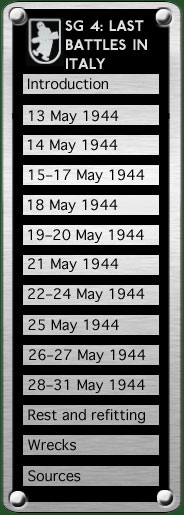|
|
|||
|
||||||||||||
By 08.00 hours, 20 Fw 190s were reported to have landed in Viterbo from Piacenza. The markings of 19 were listed: Yellow 1, 2, 3, 4, 5 White V, H, K, F, G, L "Black -- 2", "Black -- 3" Black L, K, S, O, B, Z At some point later in the day Piacenza signalled "airfield 720" (probably Canino) as follows: Request urgently information on the names of pilots and markings of the Fw 190s that landed. 17 aircraft took off here. If a reply was given, Allied Intelligence does not seem to have intercepted it. At 09.30 hours, LI. Gebirgs Korps asked Nahkampfführer Süd for immediate support from ground attack aircraft against bridge-building at reference JK9B, where allied tanks and infantry were crossing. A photo reconnaissance report at the same time showed 100 tanks and 50 motor vehicles crossing the River Garigliano at another point. A force from SG 4 was sent against the area shortly after midday. Some 18 Bf 109s from III./JG 53 took off at 12.40 hours on "protective escort", making their rendezvous with the 21 Fw 190s near Viterbo. The sequence of events is hard to unravel with certainty because the RAF and USAAF reports both describe combats at about 13.30 hrs. although the first German claims were made from 13.18 onward and I./JG 4 was involved. Four P-40s each from the 314th and 315th FS (324th FG) had taken off from Pignataro Maggiore, led by Maj. Edward A. Sanders. Their mission was armed reconnaissance and dive-bombing of a road in the area east of Cori (or, as Lt. James P. Dealy recalled it, a strike on a German troop train heading for Frosinone). Weather in the target area was 5/10 overcast and Dealy described how they followed the Liri Valley to the outskirts of Rome without seeing anything and turned back to the south east Near Gavignano (23 km east of Velletri) they were bounced by 8–10 slate grey Bf 109s which were part of the top cover for around 20 Fw 190s and enjoyed a height advantage. Half of the escorts dived to engage the Americans from six o’clock, their leader fixing on the P-40L (42-10595) of 2/Lt. Arthur F. Kusch, Jr., flying as number four of the leading section. As the P-40s dropped their bombs and broke into a defensive circle, the Bf 109 opened fire, hitting Kusch’s machine which gave off black smoke and fell into a shallow dive from about 10,000 ft. The remainder of the formation became embroiled in the fight and Kusch’s aircraft was not seen again.
The Messerschmitts, from Stab and 3./JG 4 (not the “crack ‘Ace of Spades’ Luftwaffe pilots” Dealy thought he had met) were described as experienced and able to turn with the P-40s, attacking the circle in pairs, sometimes making head-on passes. Next to be hit was Lt. O’Brien, who levelled his P-40 and bailed out. Dealy saw O’Brien’s white parachute floating down and a striped one that he thought must be German. German pilots also reported seeing a single white ‘chute at 13.20 hours. Jim Dealy got in shots at several Bf 109s before Maj. Sanders called on his men to break for a bank of cloud below. Dealy was the last to go and, intent on getting a kill, was well behind his surviving companions. He could seem them up ahead, pursued by several 109s but thought his own wingman was still behind him. He was catching up rapidly when he saw one of the P-40s pull up and shoot at a German but another Bf 109 then got on its tail. Dealy veered left and fired on the Messerschmitt “almost point blank” — he was still shooting when his “93” was itself badly hit. He pulled right and into thin cloud but the P-40 was obviously not going to make it home and he looked without success for somewhere flat enough to land. Finally he bailed out, injuring his leg and helped to evade by Italian civilians, returning to his unit after an eventful time with a group of partisans. In this engagement, I./JG 4 claimed five P-40s but as we have seen, the 324th lost three. In return, the Americans claimed 2–1–1 (among the claimants were Lts. Dealy, King and Scheiwe). The Germans lost two Bf 109 G-6: W.Nr. 162758, yellow 8, came down at Palestrina and its pilot, Uffz. Hugo Voss, was wounded; W.Nr. 162623, yellow 4 was lost at Rieti, Uffz. Heinz Thies being killed. The first of these is almost certainly attributable to the combat since the loss took place close by; the second may have been a combat-damaged aircraft that crashed after regaining friendly territory. continued on next page …
|
||||||||||||

